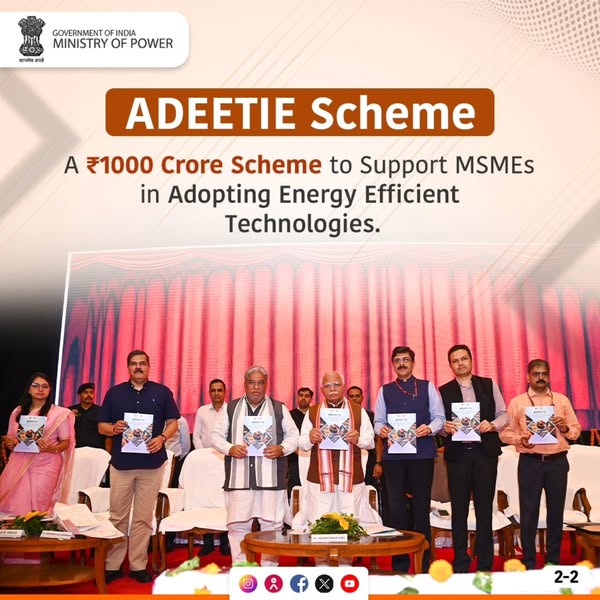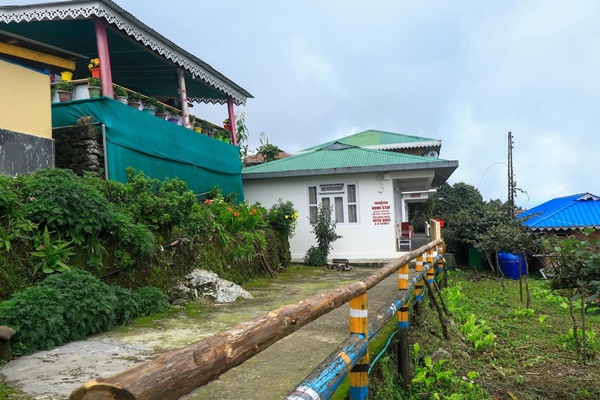ADEETIE Scheme

- 18 Jul 2025
In News:
The Ministry of Power launched the Assistance in Deploying Energy Efficient Technologies in Industries & Establishments (ADEETIE) scheme to promote energy efficiency in Micro, Small, and Medium Enterprises (MSMEs).
Key Details:
- Objective: To reduce energy consumption by 30–50%, enhance the power-to-product ratio, and facilitate the creation of green energy corridors in MSME industrial sectors.
- Implementing Agency:
- o Bureau of Energy Efficiency (BEE), under the Ministry of Power
- o Legislative backing: Energy Conservation Act, 2001
- Duration & Funding
- o Period: FY 2025–26 to 2027–28 (3 years)
- o Budgetary Outlay: ?1000 crore
- Target Beneficiaries
- Eligible Enterprises: MSMEs with Udyam ID
- Must demonstrate a minimum 10% energy savings using implemented technologies
- Sectoral Coverage: Targets 14 energy-intensive sectors, including: Brass, Bricks, Ceramics, Chemicals, Fisheries, Food Processing, etc.
- Implementation Strategy Phased Roll-out:
- Phase 1: 60 industrial clusters
- Phase 2: Additional 100 clusters
Scheme Components
|
Component |
Details |
|
Interest Subvention |
- 5% for Micro & Small Enterprises |
|
Technical Assistance |
- Investment Grade Energy Audits (IGEA) |
|
Financial Support |
- Incentives for adoption of efficient technologies |
Other BEE Initiatives for MSMEs
|
Initiative |
Purpose |
|
BEE-SME Programme |
Promote energy efficiency in MSMEs |
|
National Programme on Energy Efficiency & Technology Upgradation |
Modernize and reduce energy intensity |
|
SIDHIEE Portal |
Digital tool providing energy efficiency insights and handholding support |
Bureau of Energy Efficiency (BEE)
- The Government of India set up the Bureau of Energy Efficiency (BEE) on March 1, 2002 under the provisions of the Energy Conservation Act, 2001.
- The mission of the Bureau of Energy Efficiency is to assist in developing policies and strategies with a thrust on self-regulation and market principles, within the overall framework of the Energy Conservation Act, 2001 with the primary objective of reducing the energy intensity of the Indian economy.
- BEE coordinates with designated consumers, designated agencies and other organizations and recognises, identifies and utilises the existing resources and infrastructure, in performing the functions assigned to it under the Energy Conservation Act.
- The Energy Conservation Act provides for regulatory and promotional functions.
Prime Minister Professorships Scheme
- 18 Jul 2025
In News:
To strengthen India’s research and innovation ecosystem, the Anusandhan National Research Foundation (ANRF) has launched the Prime Minister Professorships under its flagship Promoting Advanced and Inclusive Research (PAIR) programme.
Objective
The scheme aims to:
- Utilize the expertise of retired scientists, industry professionals, and Professors of Practice
- Mentor faculty and students in State universities with emerging research ecosystems
- Address gaps in R&D capacity and promote globally competitive research
Key Features of the Prime Minister Professorship Scheme
|
Aspect |
Details |
|
Implementing Agency |
Anusandhan National Research Foundation (ANRF), under DST |
|
Eligibility |
- Superannuated scientists/faculty from reputed Indian/foreign institutions |
|
Host Institutions |
Category A State universities classified as spoke institutions under the PAIR programme |
|
Relocation Requirement |
Full-time presence at the host university is mandatory |
|
Tenure |
Up to 5 years, based on performance review |
|
Financial Support |
?30 lakh/year fellowship ?24 lakh/year research grant ?1 lakh/year overhead for host university |
|
Restrictions |
Cannot draw parallel fellowship/salary from other institutions; IP rights governed by host institution norms |
About PAIR Programme
|
Component |
Description |
|
Goal |
To foster inclusive, high-quality research in institutions with limited R&D capacity |
|
Hub Institutions |
Top 25 in NIRF rankings or Institutions of National Importance (within top 50) |
|
Spoke Institutions |
Central & State public universities, select NITs and IIITs |
|
Mentorship Ratio |
One hub can mentor up to 7 spoke institutions |
|
Participation Criteria |
|
Responsibilities of Selected Professors
- Mentor students and faculty for world-class research
- Guide establishment of labs and research facilities
- Promote interdisciplinary collaboration
- Facilitate industry-research linkages
- Provide 6-month internships at advanced labs or institutions
Significance for India’s R&D Ecosystem
- Addresses regional imbalance in research infrastructure
- Strengthens the research culture in State universities
- Enables structured national and international collaborations
- Promotes grassroots innovation and scientific leadership
India’s First Digital Nomad Village in Sikkim

- 18 Jul 2025
In News:
Yakten, a village in Pakyong district, Sikkim, was officially declared India’s first Digital Nomad Village under the ‘Nomad Sikkim’ initiative.
Objective of the Initiative
- Transform strategic locations in Sikkim into year-round hubs for digital professionals from India and abroad.
- Ensure sustainable income for homestay owners during the lean tourism season (April–October).
- Promote sustainable tourism, remote work, and grassroots entrepreneurship.
Key Features:
|
Feature |
Details |
|
Connectivity |
Village-wide Wi-Fi, dual internet lines |
|
Electricity |
Inverters for uninterrupted power supply |
|
Eco-Initiatives |
Zero-waste management, eco-friendly practices |
|
Water Security |
Long-term solution planned under Jal Jeevan Mission |
|
Employment Focus |
Aligned with CM’s “One Family, One Entrepreneur” mission |
Who is a Digital Nomad?
A digital nomad is a person who uses technology to work remotely while traveling or residing in different locations, often in scenic or peaceful areas.
Implementation Partners
- District Administration (Pakyong)
- NGO Sarvahitey
Sikkim: A Pioneer in Sustainable Development
Sikkim holds the distinction of being:
- India’s first fully organic state (2016)
- First state to achieve 100% ODF status (2016)
- First to introduce organic aquaculture
Quantum Noise and Intraparticle Entanglement
- 18 Jul 2025
In News:
A collaborative study led by the Raman Research Institute (RRI), Bengaluru, in association with Indian and international institutions, has made a groundbreaking discovery: quantum noise, often seen as a disruptive factor in quantum systems, may facilitate or even revive quantum entanglement under specific conditions.
Key Scientific Concept: Quantum Entanglement
- Quantum Entanglement: A quantum phenomenon where particles remain interconnected such that the state of one particle instantly influences the state of another, regardless of distance.
- Intraparticle Entanglement: A lesser-known form of entanglement occurring between different properties (degrees of freedom) of a single particle, as opposed to interparticle entanglement (between two or more particles).
The Discovery
- Contrary to long-held assumptions, quantum noise, specifically amplitude damping, can:
- Revive lost intraparticle entanglement
- Generate entanglement in initially unentangled intraparticle systems
- In contrast, interparticle entanglement under similar noise conditions only decays without revival.
Types of Quantum Noise Studied
- Amplitude Damping: Simulates energy loss, akin to an excited state relaxing to a ground state.
- Phase Damping: Disrupts phase relationships, impacting quantum interference.
- Depolarizing Noise: Randomizes the quantum state in all directions.
- Key Finding: Intraparticle entanglement is more robust and less susceptible to decay across all three noise types.
- Scientific Tools Used
- Derived an analytical formula for concurrence (a measure of entanglement)
- Developed a geometric representation of how entanglement behaves under noise
Institutions Involved
- Raman Research Institute (RRI) – Lead Institute (Autonomous under DST)
- Indian Institute of Science (IISc)
- Indian Institute of Science Education and Research (IISER), Kolkata
- University of Calgary
- Funded by:
- India-Trento Programme on Advanced Research (ITPAR)
- National Quantum Mission (NQM), Department of Science and Technology (DST)
Applications and Significance
- Could lead to more stable and efficient quantum systems
- Implications for Quantum Communication and Quantum Computing
- Results are platform-independent (applicable to photons, trapped ions, neutrons)
- Provides a realistic noise model (Global Noise Model) for practical quantum technologies
Maglev Technology
- 18 Jul 2025
In News:
China has successfully tested magnetic levitation (Maglev) technology, potentially enabling trains to travel faster than aircraft.
What is Maglev Technology?
Magnetic Levitation (Maglev) is an advanced transportation technology that uses electromagnetic forces to levitate and propel trains without physical contact with the track. The train is lifted off the track using opposing magnetic fields, eliminating friction and enabling extremely smooth, silent, and high-speed travel.
Origin and Development
- Inventors: Robert Goddard (USA) and Emile Bachelet (French-American) first conceptualized maglevs in the early 1900s.
- Commercial Use: Maglev systems have been operational since 1984.
How Maglev Works
Maglev trains operate on three core principles:
- Levitation: Magnets lift the train above the guideway.
- Guidance: Electromagnets maintain lateral stability.
- Propulsion: Linear motors create magnetic fields that push/pull the train forward.
- The system involves superconducting magnets or electromagnets embedded in both the train and the track (guideway).
- Recent advancements include the use of high-temperature superconducting levitation and vacuum tubes, reducing air resistance and energy loss.
Recent Breakthrough: China's Supersonic Maglev
- Developed by: China Railway Rolling Stock Corporation (CRRC)
- Top Speed Achieved: 620+ mph (998+ km/h), faster than commercial aircraft (547–575 mph).
- Latest Test Site: Donghu Laboratory, Hubei Province, June 2024.
- A 1.1-ton train accelerated to 404 mph in under 7 seconds on a 1,968-foot track inside a vacuum tube.
- Design:
- Sleek, aerodynamic nose to reduce drag.
- Spacious interior with digital displays for passenger comfort.
Future Potential
- Travel Time Reduction:
- Beijing–Shanghai: From 5.5 hours (current high-speed rail) to 2.5 hours.
- Delhi–Kolkata (if implemented in India): Estimated to take under 2.5 hours for ~1,200 km.
- Ongoing Projects: Full-scale high-speed maglev tracks expected to be completed in China by end of 2025.
Key advantages of Maglev
|
Feature |
Benefits |
|
Speed |
Exceeds 600 km/h; faster than short-haul flights |
|
Efficiency |
Lower energy loss; high acceleration/deceleration capacity |
|
Eco-Friendliness |
Zero direct emissions; compatible with renewable energy |
|
Low Maintenance |
No physical contact = minimal wear & tear |
|
Passenger Comfort |
Silent ride with negligible vibration |
